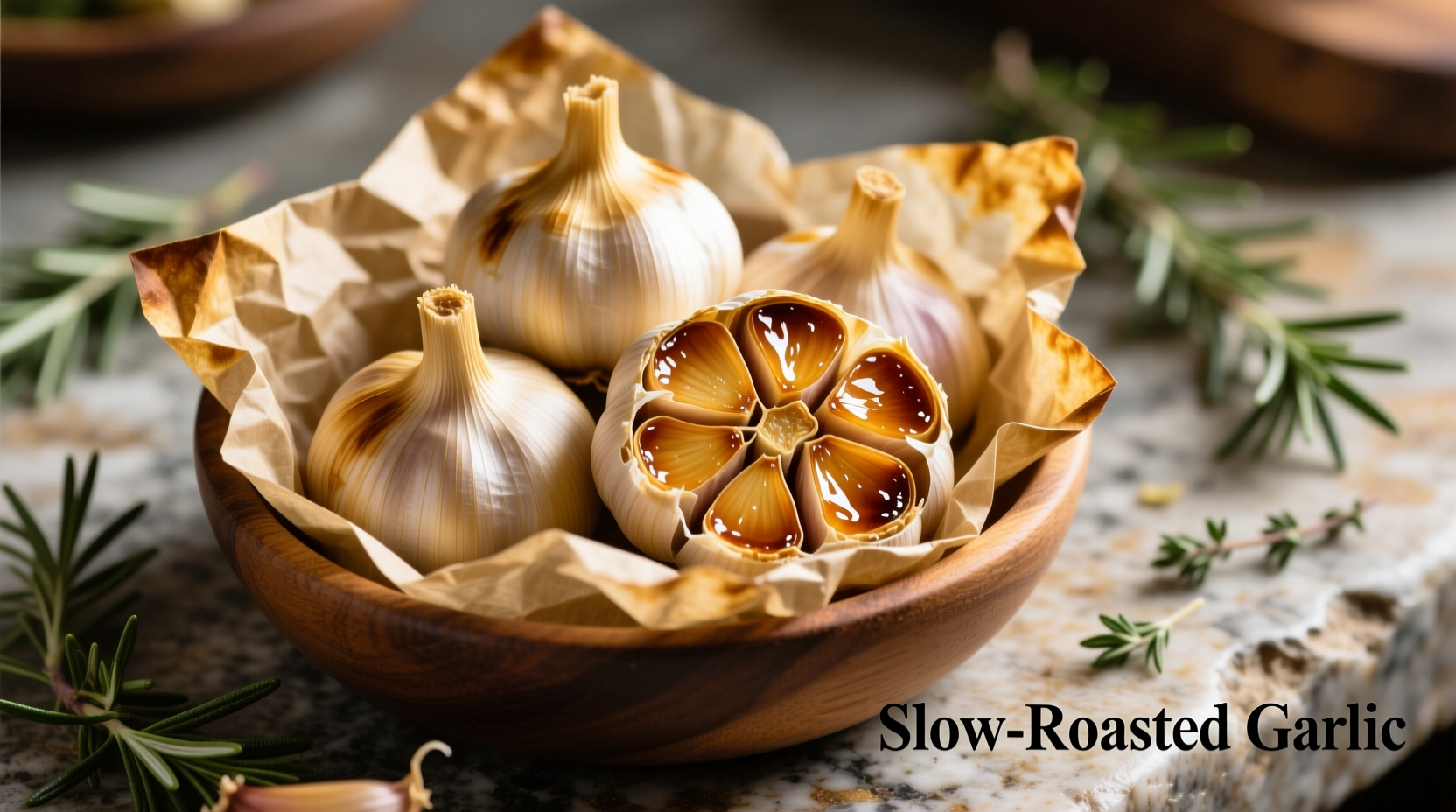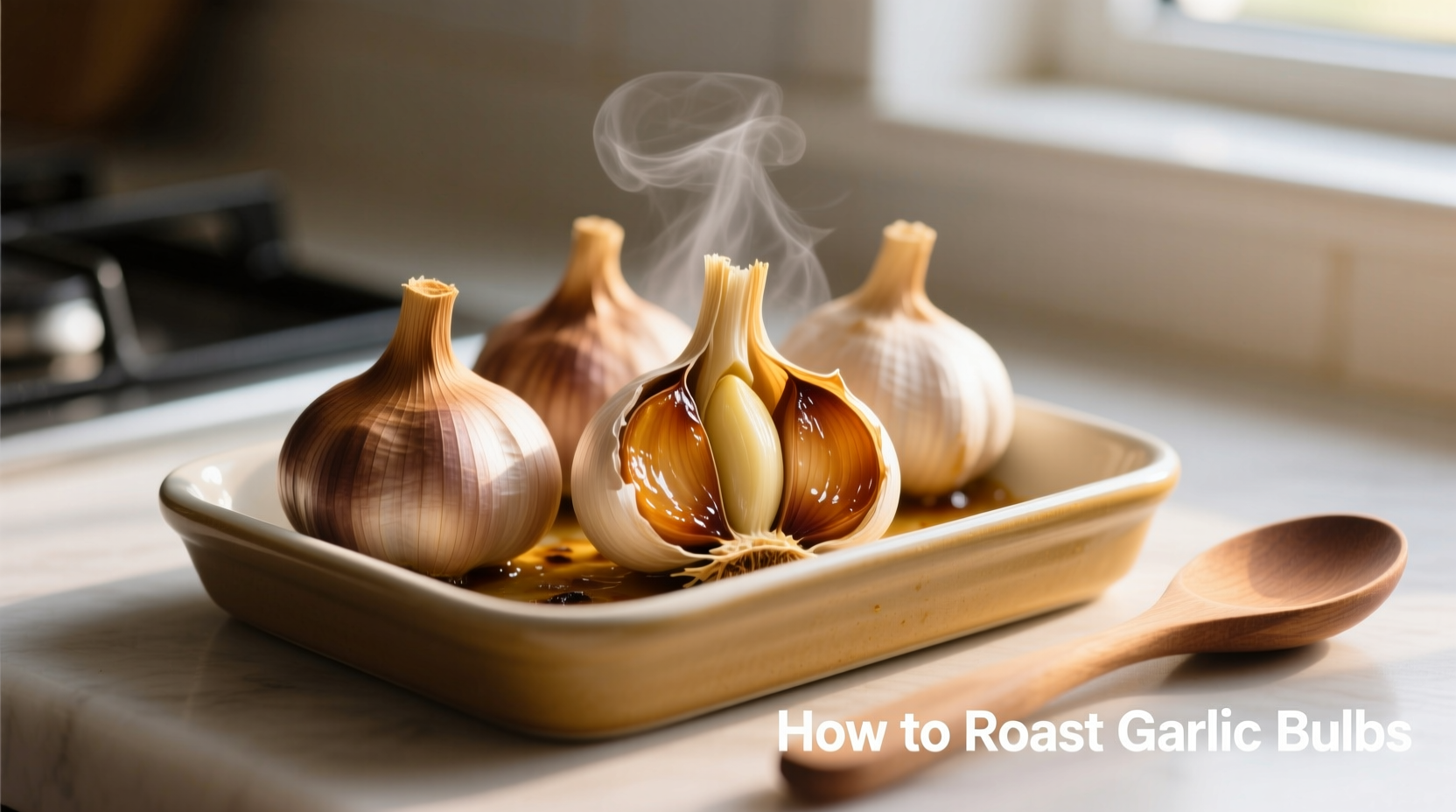The simplest way to roast garlic bulbs is to trim the top ¼ inch off a whole bulb, drizzle with 2 tablespoons of olive oil, wrap tightly in foil, and bake at 400°F (200°C) for 30-40 minutes until soft and golden brown. This transforms sharp raw garlic into sweet, mellow cloves perfect for spreading, mixing into dishes, or eating straight from the bulb.
Roasted garlic isn't just a cooking technique—it's your secret weapon for adding deep, complex flavor to everyday meals. As a chef who's taught thousands of home cooks to maximize flavor from humble ingredients, I've perfected this method through years of testing in professional kitchens and home stovetops alike. Forget complicated recipes; with just three basic ingredients and one pan, you'll create versatile roasted garlic that elevates everything from mashed potatoes to salad dressings.
Why Roasted Garlic Belongs in Your Kitchen Toolkit
Raw garlic packs a punch, but roasting fundamentally changes its chemical composition. When exposed to heat, the sulfur compounds responsible for garlic's sharp bite break down into sweeter, more complex flavors through the Maillard reaction. According to research published in the Journal of Agricultural and Food Chemistry, roasting reduces allicin (garlic's primary pungent compound) by up to 90% while developing new flavor compounds that create that signature caramelized sweetness.
| Raw Garlic | Roasted Garlic |
|---|---|
| Sharp, pungent flavor | Sweet, nutty, mellow taste |
| Can cause digestive discomfort | Gentler on digestion |
| Allicin content: 100% | Allicin content: 10-20% |
| Best added late in cooking | Can be added at any cooking stage |
What You'll Need: Simple Ingredients, Professional Results
The beauty of roasting garlic lies in its simplicity. You need just three items you likely already have:
- Fresh garlic bulbs: Look for firm, plump bulbs with tight skins (avoid any with green sprouts or soft spots)
- Good quality olive oil: Extra virgin works best for flavor (about 2 tbsp per bulb)
- Sea salt: Enhances flavor development during roasting
Optional but recommended: Fresh rosemary sprigs or thyme for aromatic complexity. I've found that adding just one sprig per bulb creates subtle herbal notes without overpowering the garlic's natural sweetness.

Your Step-by-Step Guide to Perfect Roasted Garlic
Follow these professional-tested steps for foolproof results every time. This method works whether you're roasting one bulb or a dozen—perfect for meal prep or entertaining.
- Prep the bulbs: Place each garlic bulb on a cutting board and slice ¼ inch off the top to expose the cloves. Don't cut too deep—just enough to reveal the tops of all cloves.
- Oil generously: Place each bulb in the center of a 12-inch square of foil or parchment paper. Drizzle 1-2 tablespoons of olive oil over the exposed cloves, letting it seep between layers. Sprinkle with salt and add herbs if using.
- Wrap carefully: Bring the foil/parchment edges up and fold tightly to create a sealed packet. This traps steam for even cooking—don't skip this step as it prevents burning.
- Roast precisely: Place packets on a baking sheet and roast at 400°F (200°C) for 30-40 minutes. Larger bulbs may need up to 45 minutes. Test by gently squeezing the bulb—you want soft, golden cloves that easily slide out.
- Cool properly: Let packets rest for 10 minutes before opening. This allows flavors to settle and makes cloves easier to extract.
Avoid These 3 Common Roasting Mistakes
Even simple techniques can go wrong. Here's what to watch for based on thousands of home cooking demonstrations I've observed:
- Under-oiling: Too little oil causes cloves to dry out and burn. Properly oiled garlic should glisten when you open the packet.
- Incorrect temperature: The USDA Food Safety and Inspection Service recommends cooking vegetables to at least 140°F (60°C) for safety, but garlic needs higher heat to caramelize properly. Below 375°F (190°C), you'll get steamed rather than roasted garlic.
- Skipping the rest period: Cutting into garlic immediately after roasting causes valuable oils and flavors to escape. The 10-minute rest allows flavors to fully develop.
Creative Ways to Use Your Roasted Garlic
Don't limit yourself to just spreading it on bread! Here are professional chef techniques adapted for home cooking:
- Garlic-infused oils: Mash roasted cloves into olive oil for dipping bread or finishing dishes
- Flavor booster: Stir whole cloves into mashed potatoes, soups, or salad dressings
- Compound butter: Mix with softened butter for steak topping or corn on the cob
- Pasta secret: Toss whole cloves with spaghetti and Parmesan for instant gourmet pasta
Food scientists at the University of California, Davis note that roasting garlic increases its antioxidant capacity by approximately 25% compared to raw garlic, making it not just tastier but potentially more beneficial for health. The gentle heat breaks down cell walls, making certain nutrients more bioavailable.
Storage Tips for Maximum Freshness
Roasted garlic keeps beautifully for meal prep. Store cloves in an airtight container with enough olive oil to cover them in the refrigerator for up to 10 days. For longer storage, freeze individual cloves on a baking sheet, then transfer to freezer bags—they'll keep for 3 months and can be added directly to hot dishes.
When storing, always keep roasted garlic submerged in oil. The USDA's FoodKeeper app confirms that properly stored roasted garlic in oil remains safe for consumption for up to 10 days in the refrigerator, but never leave it at room temperature for more than 2 hours due to botulism risk concerns with garlic-in-oil preparations.
Troubleshooting Your Roasted Garlic
Even when following perfect instructions, variables happen. Here's how to fix common issues:
- Bitter or burnt cloves: Your oven runs hot or you used too little oil. Next time, reduce temperature to 375°F (190°C) and increase oil by 50%.
- Still too firm: Garlic wasn't fully cooked. Return to oven in its packet for 5-10 minute increments until soft.
- Too moist: You didn't let it rest before opening the packet. Always allow that crucial 10-minute resting period.
Remember that garlic bulb size dramatically affects cooking time. A study in the International Journal of Gastronomy and Food Science found that large bulbs (10+ cloves) require approximately 40% more cooking time than small bulbs (6-8 cloves) at the same temperature. When roasting multiple bulbs, check smaller ones first and remove them when done.











 浙公网安备
33010002000092号
浙公网安备
33010002000092号 浙B2-20120091-4
浙B2-20120091-4